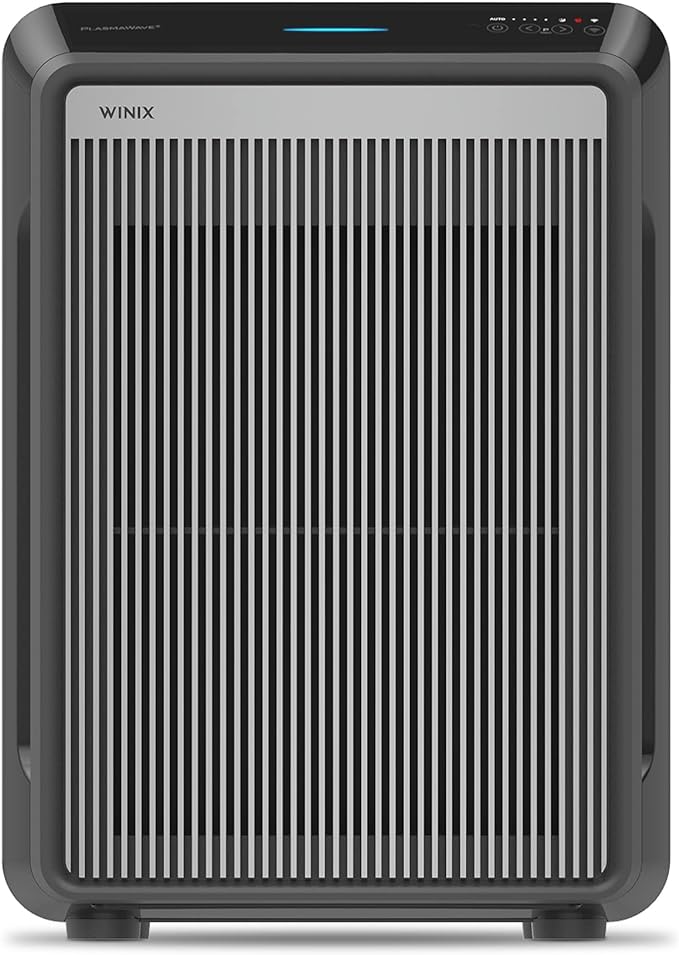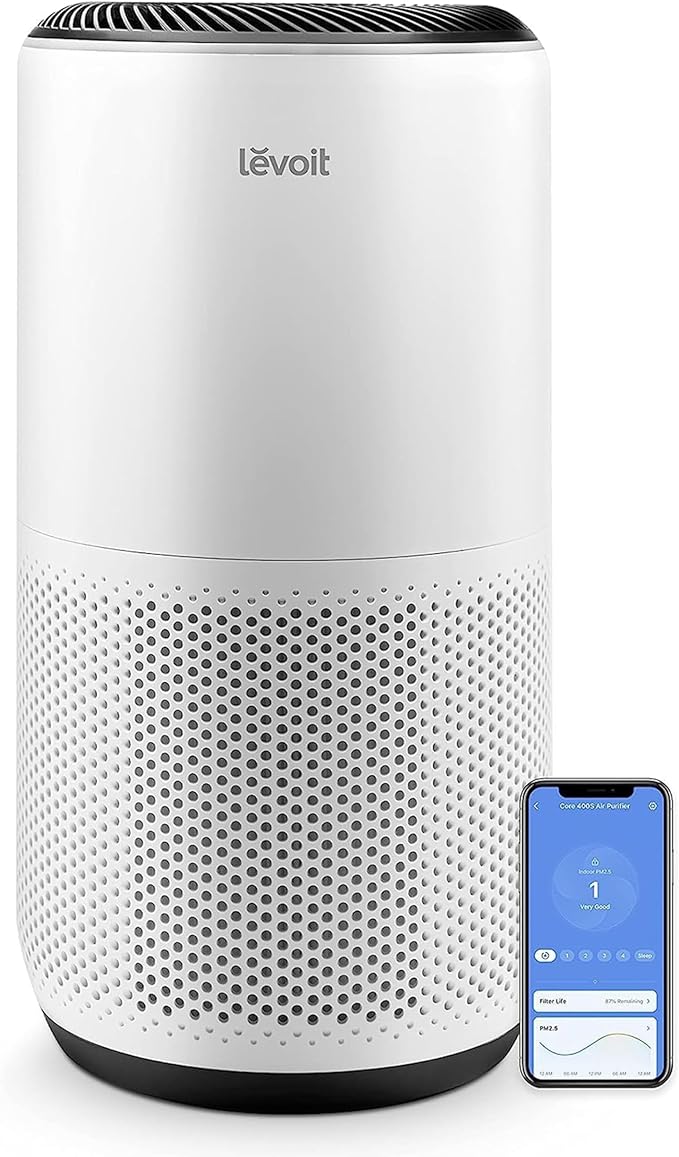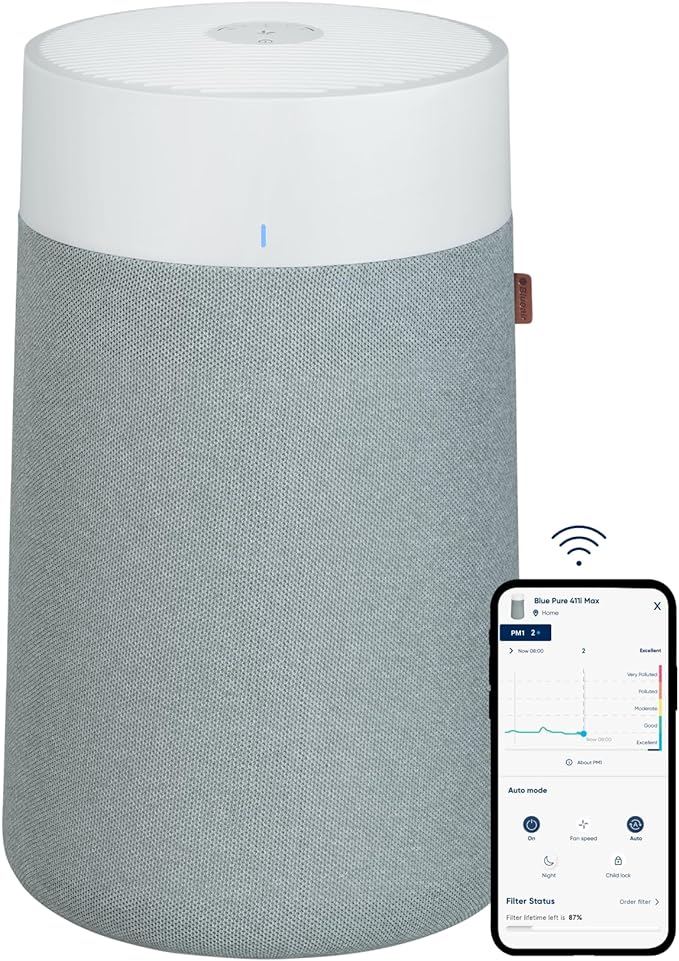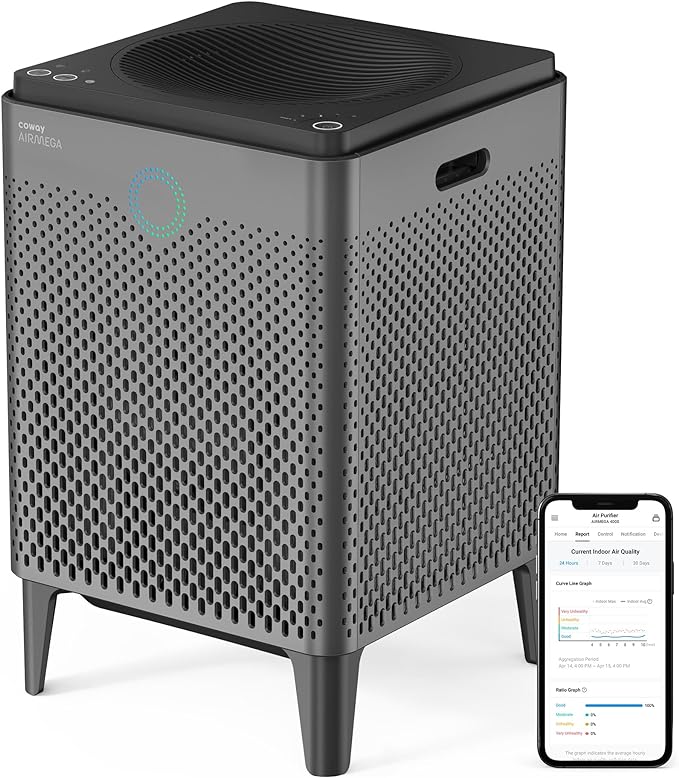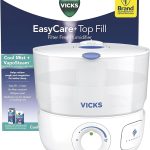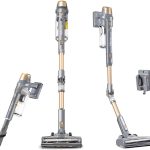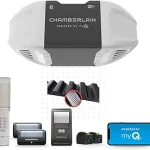Did you know that indoor air pollution can be up to five times worse than outdoor pollution? It’s a concerning reality, especially for those who spend most of their time indoors. Fortunately, smart air purifiers can help alleviate this issue. With advanced features like multi-stage filtration, quiet operation, and air quality monitoring, these devices can substantially improve indoor air quality. But which ones stand out from the rest? In the following discussion, you’ll discover the top six smart air purifiers that can help you breathe easier, from the Winix 4-Stage True Hepa Air Purifier to the Coway Airmega 400S Smart Air Purifier.
Contents
- Winix 4-Stage True Hepa Air Purifier
- Rabbit Air A3 SPA-1000N Ultra Quiet HEPA Air Purifier
- LEVOIT Air Purifiers for Home
- Blueair Air Purifiers for Bedroom and Home
- Dyson Purifier Humidify+Cool Formaldehyde™ PH04
- Coway Airmega 400S Smart Air Purifier
- Factors to Consider When Choosing Smart Air Purifiers
- Frequently Asked Questions
- Conclusion
Winix 4-Stage True Hepa Air Purifier
If you’re looking for an air purifier that can capture an impressive 99.99% of airborne particles as small as 0.003 microns, the Winix 4-Stage True Hepa Air Purifier is the best choice for you.
This air purifier features a 4-stage system that guarantees maximum air quality, and it’s equipped with PlasmaWave Technology to reduce airborne bacteria and viruses.
You’ll appreciate the Smart Sensors that detect and monitor air quality, and the Auto Mode that adjusts fan speeds for efficient cleaning.
Plus, the Sleep Mode provides quiet operation, making it perfect for bedrooms.
With its WiFi feature, you can connect to the Winix Smart App and control the air purifier remotely.
With a 4.6-star rating based on 147 customer reviews, you can trust that this air purifier will deliver on its promises.
Best For: People who suffer from allergies or asthma, or those who want to remove airborne particles, bacteria, and viruses from their indoor air.
Pros:
- Captures 99.99% of airborne particles as small as 0.003 microns, making it effective against pollen, dust, smoke, pet dander, and other ultrafine particles.
- Features PlasmaWave Technology to reduce airborne bacteria and viruses, and Smart Sensors to detect and monitor air quality.
- Offers quiet operation in Sleep Mode, making it suitable for bedrooms, and can be controlled remotely through the Winix Smart App.
Cons:
- One customer reported an issue with Alexa integration, which may be a concern for users who rely on voice control.
- Another customer was unhappy with the app’s limitations and privacy concerns, which may be a concern for users who value data privacy.
- One reviewer had a negative experience with the product, calling it “absolutely useless”, which may indicate a potential quality control issue.
Rabbit Air A3 SPA-1000N Ultra Quiet HEPA Air Purifier
The Rabbit Air A3 SPA-1000N Ultra Quiet HEPA Air Purifier is the best choice for those seeking a powerful and advanced air purification system that can tackle large spaces with ease, covering up to 1070 square feet.
You’ll appreciate its 6-stage filtration and deodorization system, which includes an advanced BioGS HEPA filter that reduces airborne allergens, dust, mold, pet dander, pollen, VOCs, bacteria, and particles that carry viruses.
With its ultra-quiet BLDC motor and 5 different speeds, you can enjoy clean air without the noise.
Plus, you can monitor air quality and control purification remotely using WiFi and Bluetooth connectivity, making it easy to breathe easy.
Best For: Those who need a powerful and advanced air purification system to tackle large spaces up to 1070 square feet.
Pros:
- Effective in removing airborne allergens, smoke, dust, mold, and VOCs
- Quiet operation with ultra-quiet BLDC motor and 5 different speeds
- WiFi connectivity allows for remote monitoring and control of air purification
Cons:
- Beveled panel on top of the unit can be difficult to see depending on placement height
- Filter kit lasts up to 2 years with 12 hours daily operation, which may require frequent replacements
- No specific mention of a timer or scheduling feature for automated operation
LEVOIT Air Purifiers for Home
For homeowners seeking a reliable and efficient air purification system, LEVOIT’s air purifiers are an excellent choice, capable of purifying air in a 403 sq ft room five times per hour.
With its 360° filtration system, you’ll enjoy cleaner air, free from gases and odors, thanks to the activated carbon filter.
The air purifier’s Middle Filter captures 99.97% of pollutants as small as 0.3 microns, and it automatically senses and reacts to changes in air quality, reporting pollution in real-time on the LCD screen and VeSync Link app.
You’ll appreciate the quiet operation in Sleep Mode and the convenience of voice control with Alexa or Google Assistant.
Best For: Homeowners seeking a reliable and efficient air purification system, particularly those with allergies or pet owners.
Pros:
- Quiet operation in Sleep Mode and programmable timer for auto shut-off
- Effective air purification with 99.97% pollutant capture rate and real-time pollution reporting
- Compatibility with voice control services like Alexa and Google Assistant for convenient use
Cons:
- Some users have reported issues with sensor accuracy
- High-speed mode can be noisy
- Filter replacement may be required periodically to maintain optimal performance
Blueair Air Purifiers for Bedroom and Home
When you need an air purifier that can quickly and quietly cleanse your living space of pollutants, the Blueair Air Purifiers for Bedroom and Home are an excellent choice, capable of cleaning up to 526sqft in just 30 minutes.
You’ll appreciate the Quiet Mark certified design, which operates at a whisper-quiet 18-46dB.
This air purifier removes 99.97% of tiny airborne particles as small as 0.1 microns, including viruses, smoke, pet dander, pollen, mold, and dust.
The carbon filter also traps light household odors from smoking, pets, and cooking.
With smart features like scheduling, air quality monitoring, and voice control through Alexa, you’ll have full control over your air quality.
Best For: Those who need a high-performance air purifier for medium to large-sized living spaces, particularly those who value quiet operation and smart features.
Pros:
- Very quiet operation with a noise level of 18-46dB, making it suitable for bedrooms and living rooms.
- Smart features like scheduling, air quality monitoring, and voice control through Alexa provide convenience and customization.
- Effectively removes 99.97% of tiny airborne particles as small as 0.1 microns, including viruses, smoke, pet dander, pollen, mold, and dust.
Cons:
- Pricier than other air purifier options on the market.
- Some users have reported issues with the Welcome Home feature, which may not work as intended.
- The air purifier may require filter replacements, which can add to the overall cost of ownership.
Dyson Purifier Humidify+Cool Formaldehyde™ PH04
If you’re seeking a multi-talented air purifier that can tackle formaldehyde, humidify the air, and provide a cool breeze, the Dyson Purifier Humidify+Cool Formaldehyde PH04 is an excellent choice, boasting a fully sealed filtration and airflow system that captures 99.97% of particles 0.3 microns in size.
This 3-in-1 device not only purifies the air but also humidifies and cools it, making it a perfect addition to your home.
With its advanced features like solid-state formaldehyde sensor and unique catalytic filter, you can trust that your air is clean and fresh.
Plus, its Wi-Fi and Bluetooth connectivity allow you to control it remotely, and its compatibility with Amazon Alexa makes it a smart addition to your smart home.
Best For: Those who want a multi-functional air purifier that can tackle formaldehyde, humidify the air, and provide a cool breeze, especially in medium-sized rooms.
Pros:
- The device’s advanced features, such as the solid-state formaldehyde sensor and unique catalytic filter, ensure clean and fresh air.
- The Wi-Fi and Bluetooth connectivity allow for remote control, and its compatibility with Amazon Alexa makes it a smart addition to any smart home.
- The device’s Air Multiplier technology and three fan modes (Fan mode, Breeze mode, and Backwards airflow mode) provide a comfortable and customizable airflow.
Cons:
- Some customers have reported issues with humidification, reliability, and customer service.
- The device may not be effective for large rooms, as its purification and humidification coverage is limited to 81m³ and 41m³, respectively.
- The device is relatively heavy (18 pounds) and may be difficult to move around.
Coway Airmega 400S Smart Air Purifier
The Coway Airmega 400S Smart Air Purifier is an ideal choice for those seeking a powerful and efficient air purifier for large rooms or open-plan living spaces, with an impressive 1,560 sq. ft. coverage in just 30 minutes.
The advanced HyperCaptive Filtration System combines a pre-filter, deodorization filter, and True HEPA Filter to reduce 99.999% of 0.01-micron particles.
You can control the air purifier via the IoCare mobile app, Amazon Alexa, or voice commands, and monitor indoor and outdoor air quality in real-time.
The smart mode automatically adjusts fan speed based on room air quality, while the eco mode turns off the fan when air quality is good for 30 minutes or more.
Best For: Large room or open-plan living space dwellers seeking a powerful and efficient air purifier that can cover a wide area quickly.
Pros:
- Offers advanced HyperCaptive Filtration System that reduces 99.999% of 0.01-micron particles
- Has a smart mode that automatically adjusts fan speed based on room air quality
- Compatible with Amazon Alexa and has voice control capabilities
Cons:
- Has a relatively high wattage of 66 watts, which may increase energy bills
- Has a noise level of 22 dB, which may be noticeable for some users
- Is a relatively large and heavy unit, weighing 25 pounds
Factors to Consider When Choosing Smart Air Purifiers
When choosing a smart air purifier, you’ll want to determine several key factors to guarantee you get the right one for your needs.
You’ll need to ponder the type of filter, the air quality sensors, and the room size coverage to get the best results.
From noise level importance to smart features integration, there are many points to weigh when making your decision.
Filter Types Matter
Your air purifier’s filter type is a critical factor to examine, as it directly impacts the device’s effectiveness in capturing pollutants and allergens that affect indoor air quality.
When choosing a smart air purifier, you’ll likely come across three main filter types: HEPA, Activated Carbon, and pre-filters.
HEPA filters, the most common type, capture 99.97% of particles as small as 0.3 microns, including dust, pollen, and other allergens.
Activated Carbon filters specialize in removing gases, odors, and VOCs, often used in combination with HEPA filters for thorough air purification.
Pre-filters, often washable, capture larger particles like hair and dust, extending the life of more sensitive filters and improving overall air purifier performance.
Some air purifiers may also use Ionization or UV light technology, but these methods may not be as effective as physical filters.
You must choose an air purifier with a filter that addresses your specific air quality concerns, such as pet allergies or smoke removal.
Air Quality Sensors
Air quality sensors in smart air purifiers play a crucial role in detecting pollutants and particles as small as 0.3 microns, including dust, pollen, pet dander, and other allergens, allowing you to monitor and respond to indoor air quality issues effectively.
These sensors are designed to provide real-time monitoring, giving you an accurate picture of your indoor air quality. Some smart air purifiers take it a step further by detecting specific pollutants like formaldehyde, giving you a more detailed understanding of your air quality.
The accuracy and reliability of these sensors can vary between products, so you must look for models that use multiple sensors to guarantee accurate readings.
When pollutants are detected, the sensors can trigger automatic adjustments to fan speed and purification modes to maximize air cleaning. Some smart air purifiers can even integrate with outdoor air quality data to provide a more detailed picture of air quality and suggest ideal purification settings.
Room Size Coverage
When selecting a smart air purifier, room size coverage is an essential factor to consider to ensure the device can effectively clean the air in your specific space. A model that’s too small won’t be able to handle the air quality demands of a larger room.
If you’re looking to purify the air in a compact space, such as a bedroom or nursery, a smaller model with a coverage area of around 100-200 square feet might be sufficient.
However, if you need to cover a larger area, like a living room or open-plan office, you’ll require a more powerful model that can handle 500-1000 square feet or more.
When checking the room size coverage, consider the specific dimensions of the space you want to purify. Don’t forget to factor in any obstacles, such as furniture or walls, that might affect airflow.
Some smart air purifiers come with adjustable fan speeds, which can help increase their coverage area. Be sure to check the manufacturer’s specifications to confirm you’re getting a model that can handle your specific needs.
Noise Level Importance
When selecting a smart air purifier, considering the noise level is essential, as excessive noise can disrupt daily activities and sleep patterns, making it essential to find a model that suits your specific needs.
You’ll want to choose an air purifier that won’t disturb your sleep or daily routine.
A noise level of 20-30 dB is considered whisper quiet, making it suitable for bedrooms and living rooms.
If you plan to use the air purifier in a home office or kitchen, a noise level of 40-50 dB might be more acceptable.
The US Environmental Protection Agency recommends keeping noise levels below 45 dB to minimize sleep disturbance and cardiovascular disease.
Some air purifiers, like the Winix 4-Stage True HEPA Air Purifier, have a Sleep Mode that reduces noise levels to as low as 26.2 dB for quiet operation.
Look for air purifiers with low noise levels, such as the Rabbit Air A3 SPA-1000N, which has a noise level of 20.3 dBA at its lowest speed.
Smart Features Integration
With smart features integrated into your air purifier, you’re able to take control of your indoor air quality from anywhere, using your smartphone to monitor and adjust settings remotely.
This means you can stay informed about the air quality in your home, even when you’re not there. Many smart air purifiers come with mobile apps that allow you to check pollutant levels, air quality indexes, and even receive notifications when the air quality drops.
Moreover, you can use voice assistants like Amazon Alexa to control your air purifier with just your voice, making it even more convenient.
Some smart air purifiers also offer geofencing capabilities, automatically turning the device on or off based on your proximity to the device. Additionally, you can customize your air purifier’s schedule to fit your daily routine, turning it on or off when you need it to.
With smart features integration, you can enjoy the convenience of a high-tech air purifier that adapts to your needs.
Maintenance and Filters
As you take advantage of the convenience of smart air purifiers, it’s equally important to remember the maintenance and filter replacement requirements that come with them.
You’ll need to think about the type of filters used in your air purifier, as well as their replacement frequency. Some models have washable filters that can be cleaned and reused, while others have disposable filters that need to be replaced entirely.
For example, HEPA filters typically need to be replaced every 6-12 months, depending on usage and air quality. Activated carbon filters, which remove gases and odors, may need to be replaced every 3-6 months.
Fortunately, some air purifiers come equipped with indicators that alert you when the filters need to be replaced or cleaned, making maintenance easier and more convenient.
Be sure to check the specific maintenance requirements for your air purifier to guarantee it continues to run efficiently and effectively. By doing so, you’ll be able to breathe easy, knowing your air purifier is working hard to keep your air clean and healthy.
Energy Efficiency Counts
You’ll likely want to prioritize energy efficiency when selecting a smart air purifier, given its significant impact on your utility bills and the environment.
Energy-efficient air purifiers can help reduce energy consumption, with some models using as little as 24 watts of power. Look for air purifiers with the ENERGY STAR certification, which indicates that they meet energy efficiency standards set by the U.S. Environmental Protection Agency.
Some smart air purifiers come with features like auto-mode, which adjusts fan speed based on air quality, to optimize energy consumption and minimize waste. Not only will this help reduce your energy bills, but it’ll also contribute to a more sustainable future.
In fact, energy-efficient air purifiers can help reduce greenhouse gas emissions, with some models emitting as little as 0.15 kg of CO2 per year.
When shopping for an energy-efficient air purifier, be sure to check the wattage and voltage requirements, as well as the estimated annual energy cost. This will help you make an informed decision and find a model that fits your needs and budget.
Frequently Asked Questions
Can Air Purifiers Remove Odors and Smoke From the Air?
You’re wondering if air purifiers can remove odors and smoke from the air. The answer is yes, they can! Many air purifiers use activated carbon filters that absorb and neutralize unpleasant smells and particles.
Do Air Purifiers Require Frequent Filter Replacements?
You’ll find that air purifiers do require frequent filter replacements to maintain their effectiveness, with most needing a swap every 3-6 months, depending on usage and air quality, to keep your air clean and fresh.
Are Air Purifiers Suitable for People With Asthma?
You’re wondering if air purifiers are suitable for people with asthma. Fortunately, yes, they can be a game-changer for you, helping to alleviate symptoms by removing triggers like dust, pollen, and pet dander from the air.
Can Air Purifiers Be Controlled Remotely Through an App?
You’re wondering if air purifiers can be controlled remotely through an app. Yes, many modern air purifiers can be controlled and monitored remotely using a mobile app, allowing you to adjust settings and track air quality from anywhere.
Do Air Purifiers Consume a Lot of Electricity?
You’ve probably worried that running an air purifier 24/7 would skyrocket your electricity bill, but surprisingly, most models consume less power than your average laptop, using around 20-50 watts, which is relatively low.
Conclusion
You’ve narrowed down the options to the top 6 smart air purifiers, each with its unique strengths.
The Winix 4-Stage True Hepa Air Purifier excels in capturing tiny particles, while the Rabbit Air A3 SPA-1000N Ultra Quiet HEPA Air Purifier covers large spaces.
The LEVOIT and Blueair air purifiers offer quiet operation, and the Dyson Purifier Humidify+Cool Formaldehyde PH04 tackles formaldehyde.
The Coway Airmega 400S Smart Air Purifier boasts a 5-stage filtration system.
Visualize your ideal air purifier by considering factors like coverage area, filter type, and noise level to breathe easy.
